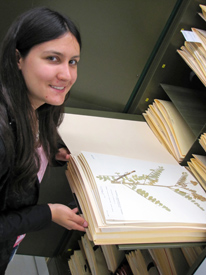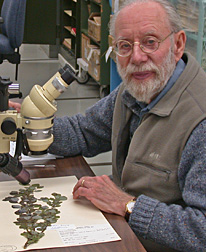- Home>
- Research & Collections>
- Collections>
- Botany Collections: The National Herbarium of Canada
Allan G. Austin © Canadian Museum of Nature
Close.Botany Collections: The National Herbarium of Canada
Plants and Algae
© Canadian Museum of Nature
A Brief Herbarium History
The National Herbarium of Canada at the Canadian Museum of Nature was created when the plant collections of the Geological and Natural History Survey of Canada were officially incorporated into a museum department in 1882.
At that time, John Macoun was hired as the museum's first biologist; his primary interest was botany. Macoun built up a sizable collection of approximately 100 000 plants (including photosynthetic protists, and lichens), known as a herbarium, before his semi-retirement in 1911. As a result of Macoun's collecting and trading endeavours, and of government-supported Canadian exploration, the museum's plant collections are rich in historic specimens dating back to 1766.
A.E. Porsild was hired as the museum's botanist in 1936, and with his specific interest in Arctic botany, he developed the Canadian National Herbarium into a world-class Arctic plant collection that today holds more than 100 000 Arctic plant specimens.
Today, the museum's four plant collections (vascular plants, bryophytes, lichens and algae) together contain well over one million plant specimens, comprising one of Canada's largest plant collections.
Curator: Jennifer Doubt.
The Collections
The four collections of the National Herbarium of Canada are each considered to be a national collection for its discipline, each with a unique international code.
© Canadian Museum of Nature
Algae
Our Algae Collection (CANA) consists of 26 640 specimens. More than 300 are type specimens. The collection also includes a complete set of the Phycotheca Boreali-Americana exsiccata. Diatoms comprise about two-thirds of the collection, although specimens representing all algal types are present. Search the phycology-collection specimen database.
Lichens and Allied Fungi
Our Lichen Collection (CANL) represents the largest collection of Canadian lichens in the world, and the foundation for Irwin Brodo's ground-breaking resource The Lichens of North America. The collection currently contains more than 136 170 catalogued specimens, including about 750 type specimens. The collection also includes many exsiccata sets.
Lichens (lichenized fungi) and allied fungi, including those growing on lichens (lichenicolous fungi), are the only fungal specimens at CANL. The Canadian National Mycological Herbarium (DAOM) at Agriculture and Agrifood Canada curates non-lichenized fungi.
Bryophytes
Our Bryophyte Collection (CANM) contains more than 268 000 samples of mosses, liverworts and hornworts, including about 950 type specimens. Prolific work by Robert Ireland (Moss Flora of the Maritime Provinces), who built the collection through research and curatorship, is represented here. The collection is also known for unique historical specimens.
Vascular Plants
Our Vascular Plant Collection (CAN) offers an excellent representation of native species from north temperate regions, with a strong emphasis on Canadian species. There are more than 650 000 herbarium sheets, including about 2500 type specimens. Arctic botany has always been a key strength of the collection, alongside the evolving taxonomic interests represented in our research staff (currently willows, grasses, sedges, legumes and spurges).
Martin Lipman © Canadian Museum of Nature
Cultural Treasure
The vast majority of herbarium specimens of each species—whether collected by famous explorer John Franklin or by our current research team—are grouped together in the collection. However, the National Herbarium also safeguards about 60 exquisite small collections for which there is overriding cultural value in keeping mixed material from a single collector or project together. Just one example: original "scrapbooks" by pioneering author and naturalist Catharine Parr Traill. Each compiles many plants and notes, thereby revealing the experience and observations of a naturalist and newcomer to Canada in the 1800s.
Please Visit
Visitors are very welcome in the National Herbarium of Canada. In fact, it's a key part of our mandate. Visitors add value to the plant collection by sustainably using collections for education and research in botany, ecology, conservation, history, literature, art and more. They share the knowledge gained from their use of the specimens, thereby multiplying the benefits and building an even better collection for future visitors.
If you have a project or question that the collection may help you with, please contact us to learn more, or to arrange a visit.
Search Our Collections
Online Database
Access data from the museum's collections: search, map results, and download data and images. Search our collections.










